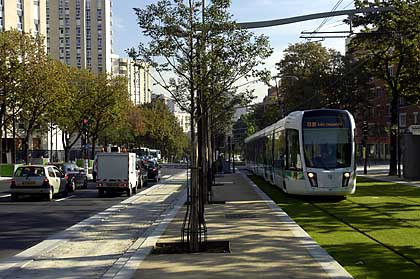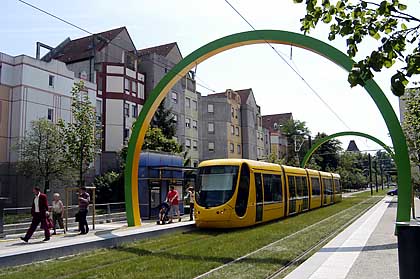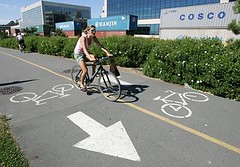World class Bethesda and second city Paris, France (Paris being sullied by light rail)
 Purple Line image from Sierra Club Metro DC- Challenge to Sprawl Campaign. (This is my most viewed Flickr image with more than 800 views.)
Purple Line image from Sierra Club Metro DC- Challenge to Sprawl Campaign. (This is my most viewed Flickr image with more than 800 views.)I mentioned a couple weeks ago that Paris has introduced a "tram" (light rail) into the city proper; they already have two other tram routes in the suburbs. See "Can Paris be an example for DC's Maryland suburbs?"
I have written about the proposed Purple Line a lot. It is a great victory for Montgomery and Prince George's County transit advocates to have gotten the Purple Line back near the top of the suburban Maryland transit agenda after it had been trumped by the Inter County Connector.
Two Saturdays ago Roger Lewis wrote a piece in the Post Real Estate section calling for the Inter County Connector (ugh) as well as the Purple Line. (See "My 2007 Wish List: An Intercounty Connector, a Purple Line...")
 New tram line in Paris. Photo courtesy of Paris Tramway.
New tram line in Paris. Photo courtesy of Paris Tramway.This was too much for John Warnock of Chevy Chase, who "serves on the board of the Greater Bethesda-Chevy Chase Coalition, which has fought to preserve the Georgetown Branch of the Capital Crescent Trail." In a letter to the editor of the Post, he wrote:
The Purple Line, as envisioned by its advocates, would cut wide swaths of destruction through residential areas of Bethesda, Chevy Chase and Silver Spring. It would also result in the destruction of the Georgetown Branch of the Capital Crescent Trail. The certainty of this calamity is why we who oppose the Purple Line have argued for years that its original and strongest transit justification -- linking the two arms of the Red Line -- would be far better served by a deep tunnel that would permit regular Metro trains to make the connection.
 Tram in Mulhouse France, Der Spiegel photo.
Tram in Mulhouse France, Der Spiegel photo.I'll admit, were I the czar of the transit budgets at the Federal and Maryland State government, I would make the Purple Line an underground line, using the same technology as the current WMATA system. Unfortunately, I'm not that czar, and so surface based transit has to be the way to go.
Now, I don't see why Paris has escaped the kind of destruction of neighborhoods and bicycle and walking paths that Mr. Warnock says is the specter faced by Bethesda? See "Un Tramway Nommé Désir: Streetcars Make a Comeback in Paris" from Der Spiegel International for more on the Paris Tram. From the article:
Broad walkways and bicycle routes, parks with thousands of specially planted trees, and city-commissioned art works all belong to the package. They help turn the new tram line into a showcase for urban progress. "Here we've converted a main artery of automobile traffic to a place of life and a promenade," one of the mayor's assistants explains. And designer in chief Yo Kaminagai, who developed the overall concept for the T3, sees the new vehicle as a "a symbol of the future -- just like the subway was a century ago." ...
The return to collective forms of urban transportation started with rising energy costs and with the car-traffic crisis in inner cities. Eight French cities participated in a government project aimed at bringing new, modern transportation technology to the city centers. After Nantes, it's mainly Strasbourg that has begun to expand its tram network as part of a larger urban vision. The windowed, streamlined coaches, which not only hold plenty of passengers but are also quiet and comfortable, have become a showcase for up-to-date and ecologically correct transportation policies. ...
"The tram is a grand tool for urban renewal projects," says Michel Duchêne, the vice mayor of Bordeaux. A tram line requires a smaller initial investment than a subway line. That and its average speed of 20 kilometers an hour (12 mph) make it an attractive alternative -- albeit it one motorists tend to see as a liability.
Instead of satisficing the line to make it cheap and ugly, Paris (and other French cities) have used transit to enhance their communities and move forward, achieving multiple simultaneous objectives.
Plus, as I wrote about some time ago, bike paths and train tracks are not incompatible, at least they aren't in San Diego, California and Seattle, Washington, which if not world class cities, are at least national class cities. (See "Trains, light-rail co-exists with bike trails in Seattle." )
 Bicyclists and trains seem to co-exist without incident along Seattle's Elliott Bay trail. Similar options are being considered as King County looks to buy the rail corridor from Renton to Snohomish. KEN LAMBERT / THE SEATTLE TIMES.
Bicyclists and trains seem to co-exist without incident along Seattle's Elliott Bay trail. Similar options are being considered as King County looks to buy the rail corridor from Renton to Snohomish. KEN LAMBERT / THE SEATTLE TIMES.Many people aver that people like Mr. Warnock seize on the Crescent Trail as a chimera, using it to block transit over all, because they know that the region won't pony up for the cost of WMATA subway class service, which costs $400 million/mile just for tunneling--add track, stations, and everything else, and the cost is significantly higher than light rail. The cost of the Paris tram is about $80 million/mile. Still not cheap, but significantly lower than heavy rail.
And I have occasion to work next to the tracks in Brookland quite a bit late at night, when many trains run through. They aren't that loud. Although the subway line is louder than the trains.
 Light Rail in Barcelona. Photo by John Norquist.
Light Rail in Barcelona. Photo by John Norquist.-------
Also see this piece from the Kansas City Star, on a light rail referendum there, "Heavy hitters bolster light rail: In a switch, Kansas City VIPs back Chastain’s concept, if not the voter-approved details." Interestingly, it talks about highway-based light rail systems oriented to the commuter. While rail-based transit systems rely on commuters for a large chunk of ridership, highway-based systems tend to have limited revitalization and economic development effects.
All the more reason to favor the Purple Line concept, maybe less so between Bethesda and Silver Spring, but more so beyond to New Carrollton, and from New Carrollton to Alexandria.
Index Keywords: transit



0 Comments:
Post a Comment
<< Home